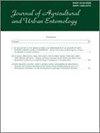阿肯色州桃树小螟虫的遗传变异(鳞翅目:绢蚜科)
Q2 Agricultural and Biological Sciences
The Journal of Agricultural and Urban Entomology
Pub Date : 2008-01-01
DOI:10.3954/1523-5475-25.1.25
引用次数: 4
摘要
摘要:桃树小螟虫(Synanthedon pictipes, LPTB)属于经济上重要的鳞翅目桃科。关于Snyanthedon属的遗传变异和种群结构的研究尚未发表。研究了阿肯色州3个LPTB人群线粒体细胞色素氧化酶I基因(COI)、tRNA-leu和细胞色素氧化酶II基因(COII) 603bp区域的DNA序列差异。从3个群体收集的114个LPTB中,共有53个核苷酸位点存在多态性,并观察到12个不同的单倍型。最常见的单倍型出现在88%的LPTB样本和所有三个人群中。单倍型间序列差异在0.2% ~ 8.8%之间。根据鳞翅目mtDNA的标准分子钟,单倍型已经分化了250万年。单倍型多样性最大的是没有维持蛀虫管理的费耶特维尔种群。在Clarksville, Springdale和Fayetteville人群中观察到高水平的基因流动,这表明LPTB具有广泛的传播范围。对12个单倍型的家谱关系和系统发育分析支持三个遗传上不同但形态上难以区分的亚种的存在。本文章由计算机程序翻译,如有差异,请以英文原文为准。
Genetic Variation of the Lesser Peach Tree Borer, Synanthedon pictipes (Lepidoptera: Sesiidae) in Arkansas
Abstract The lesser peach tree borer, Synanthedon pictipes (LPTB), belongs to the economically important Lepidopteran family Sesiidae. No studies on genetic variation or population structure on the genus Snyanthedon have been previously published. We examined DNA sequence variation in a 603 bp region of the mitochondrial cytochrome oxidase I gene (COI), tRNA-leu and cytochrome oxidase II gene (COII) from three LPTB populations in Arkansas. From 114 LPTB collected from three populations, a total of 53 nucleotide positions were polymorphic, and 12 distinct haplotypes were observed. The most frequent haplotype occurred in 88% of the sampled LPTB's and in all three populations. Sequence divergence among haplotypes ranged from 0.2% to 8.8%. According to the standard molecular clock proposed for lepidopteran mtDNA, the haplotypes have been diverging for up to 2.5 million years. The greatest amount of haplotype diversity was observed in the Fayetteville population where borer management is not maintained. High levels of gene flow were observed among the Clarksville, Springdale and Fayetteville populations suggesting the LPTB has a broad dispersal range. Examination of the genealogical relationships and phylogenetic analysis of the 12 haplotypes supports the existence of three genetically distinct but morphologically indistinguishable subspecies.
求助全文
通过发布文献求助,成功后即可免费获取论文全文。
去求助
来源期刊

The Journal of Agricultural and Urban Entomology
Agricultural and Biological Sciences-Insect Science
CiteScore
1.40
自引率
0.00%
发文量
2
期刊介绍:
The Journal of Agricultural and Urban Entomology (JAUE) (Journal of Agricultural Entomology, Jan 1984 - Oct 1998 volumes 1-15) is published under the auspices of the South Carolina Entomological Society (SCES). The Journal publishes contributions of original research concerning insects and other arthropods of agricultural and urban importance to include those affecting humans, livestock, poultry, and wildlife. JAUE is particularly dedicated to the publication of articles and notes pertaining to applied entomology, although it will accept suitable contributions of a fundamental nature related to agricultural and urban entomology.
 求助内容:
求助内容: 应助结果提醒方式:
应助结果提醒方式:


